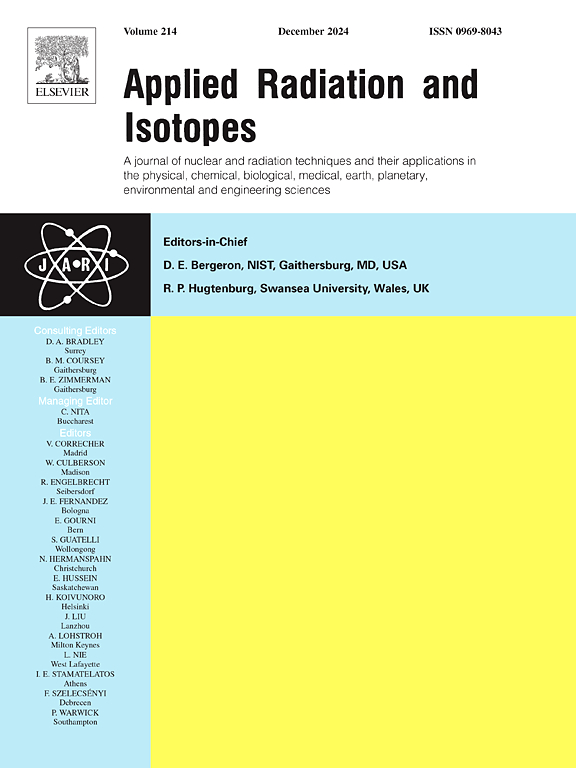邻十二硼酸偶联4-(对碘苯基)丁酸(PBC-IP)对头颈部鳞状细胞癌(SAS)模型小鼠的硼中子俘获治疗
IF 1.6
3区 工程技术
Q3 CHEMISTRY, INORGANIC & NUCLEAR
引用次数: 0
摘要
硼中子俘获疗法(BNCT)是治疗难治性癌症的一种有吸引力的治疗方法。目前,4-硼- l -苯丙氨酸(BPA)是唯一被批准用于BNCT的硼载体,特别是在日本不可切除的、局部晚期或复发的头颈癌。然而,BPA的功效依赖于l型氨基酸转运蛋白(LAT1),该蛋白在许多癌症中高度表达,限制了其更广泛的应用。在这项研究中,我们研究了一种新型硼载体的潜力,翼酰-近十二硼酸偶联4-(对碘苯基)丁酸(PBC-IP),设计用于叶酸受体(FRs),作为头颈癌BNCT的替代品。将PBC-IP注射到人头颈部鳞状细胞癌SAS异种移植小鼠体内,比较其生物分布及与BPA的治疗效果。我们的研究结果表明,尽管肿瘤中的硼浓度低于BPA(分别为5 μg [10B]/g和15 μg [10B]/g),但PBC-IP实现了肿瘤的选择性积累。PBC-IP具有显著的肝脏代谢。用PBC-IP处理BNCT可抑制小鼠肿瘤生长,而BPA的效果更佳,几乎可以消除肿瘤。重要的是,两组均未观察到明显的毒性。这些发现表明,虽然PBC-IP显示出BNCT靶向fr表达肿瘤的一些潜力,但BPA仍然是头颈癌更有效的选择。本文章由计算机程序翻译,如有差异,请以英文原文为准。
Boron neutron capture therapy with pteroyl-closo-dodecaborate-conjugated 4-(p-iodophenyl)butyric acid (PBC-IP) for a head and neck squamous cell carcinoma (SAS) model mice
Boron neutron capture therapy (BNCT) is an attractive therapeutic approach for treating refractory cancers. Currently, 4-borono-L-phenylalanine (BPA) is the only boron carrier approved for BNCT, specifically for unresectable, locally advanced, or recurrent head and neck cancers in Japan. However, efficacy of BPA relies on the L-type amino acid transporter (LAT1), which is highly expressed in many cancers, limiting its broader application. In this study, we investigated the potential of a novel boron carrier, pteroyl-closo-dodecaborate-conjugated 4-(p-iodophenyl)butyric acid (PBC-IP), designed to the folate receptors (FRs), as an alternative for BNCT in head and neck cancers. PBC-IP was injected into human head and neck squamous cell carcinoma SAS xenograft mice to assess its biodistribution and therapeutic efficacy compared to BPA. Our results showed that PBC-IP achieved selective tumor accumulation, although the boron concentration in tumors was lower than that of BPA (5 μg [10B]/g vs. 15 μg [10B]/g, respectively). PBC-IP underwent significant hepatic metabolism. BNCT treatment with PBC-IP suppressed tumor growth in mice, whereas BPA showed superior efficacy, nearly eliminating tumors. Importantly, no significant toxicity was observed in either group. These findings suggest that while PBC-IP exhibits some potential for BNCT targeting FR-expressing tumors, BPA remains the more effective option for head and neck cancer.
求助全文
通过发布文献求助,成功后即可免费获取论文全文。
去求助
来源期刊

Applied Radiation and Isotopes
工程技术-核科学技术
CiteScore
3.00
自引率
12.50%
发文量
406
审稿时长
13.5 months
期刊介绍:
Applied Radiation and Isotopes provides a high quality medium for the publication of substantial, original and scientific and technological papers on the development and peaceful application of nuclear, radiation and radionuclide techniques in chemistry, physics, biochemistry, biology, medicine, security, engineering and in the earth, planetary and environmental sciences, all including dosimetry. Nuclear techniques are defined in the broadest sense and both experimental and theoretical papers are welcome. They include the development and use of α- and β-particles, X-rays and γ-rays, neutrons and other nuclear particles and radiations from all sources, including radionuclides, synchrotron sources, cyclotrons and reactors and from the natural environment.
The journal aims to publish papers with significance to an international audience, containing substantial novelty and scientific impact. The Editors reserve the rights to reject, with or without external review, papers that do not meet these criteria.
Papers dealing with radiation processing, i.e., where radiation is used to bring about a biological, chemical or physical change in a material, should be directed to our sister journal Radiation Physics and Chemistry.
 求助内容:
求助内容: 应助结果提醒方式:
应助结果提醒方式:


